Toyota Prius 4 (XW50)
Compact HatchbackProduct Gallery
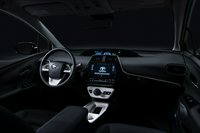
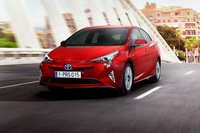
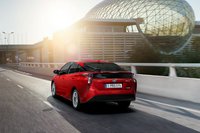
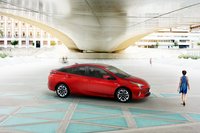
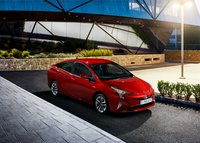
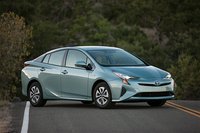
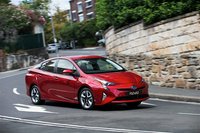
Product Overview
Toyota Prius 4 (chassis code XW50) is a mid-size hatchback in production from 2015 to 2018, whereupon it received a facelift. It was powered by a 1.8L Atkinson Cycle I4 petrol engine aided by a couple of motor-generators in the e-CVT.
Compared to the Mk3 Prius, the Prius 4 boasts significant improvements in exterior and interior design. The vehicle feels much upscale, too. Moreover, Toyota introduced fully independent rear suspensions to improve the ride comfort of the vehicle.
Even though at this point hybrid drivetrains have become commonplace in the automotive industry, Toyota managed to keep the Prius a superb choice.
Another plus is the small 10.2m (33.5ft) turning circle.
Ratings
What we found
Neofiliac score 38%
Pros
- Superb exterior design
- Very low fuel consumption
- Small turning circle
- Exceptional drivetrain reliability
Cons
- Horrible 0-100kph time
- Can't even reach 200km/h
What external reviewers found
External score 55%
Pros
- Excellent fuel economy
- Decent range-topping standard equipment
- Comfortable to drive
- Gorgeous looks
Cons
- EV mode is still poor
- Cheap-feeling interior
- Noisy CVT gearbox
- Alternatives are more fun to drive
Your rating:
12345678910
?/10
Price Comparison
As associates of the merchants above, we earn a commission when you make a purchase using the supplied links.
Specifications
[{"Ft":"Capacity","Fn":"Cargo Capacity","Fv":"501 L / 17.7 cu-ft"},{"Ft":"Capacity","Fn":"Fuel Capacity","Fv":"43.0 L / 11.4 gal"},{"Ft":"Capacity","Fn":"Passengers","Fv":"5"},{"Ft":"Capacity","Fn":"Payload","Fv":"415 kg / 915 lbs"},{"Ft":"Chassis","Fn":"Brakes | Front","Fv":"Ventilated discs"},{"Ft":"Chassis","Fn":"Brakes | Rear","Fv":"Disc"},{"Ft":"Chassis","Fn":"Power Steering","Fv":"Electric Steering"},{"Ft":"Chassis","Fn":"Suspension | Front","Fv":"MacPherson strut"},{"Ft":"Chassis","Fn":"Suspension | Rear","Fv":"Multi-link"},{"Ft":"Chassis","Fn":"Tire Size","Fv":"195/65 R15, 215/45 R17"},{"Ft":"Chassis","Fn":"Turning Circle","Fv":"10.2 m / 33.5 ft"},{"Ft":"Construction","Fn":"Battery | Capacity","Fv":"1.3 kWh (gross)"},{"Ft":"Construction","Fn":"Body Style","Fv":"5-door hybrid Hatchback"},{"Ft":"Dimensions","Fn":"Ground Clearance","Fv":"123 mm / 4.8 in"},{"Ft":"Dimensions","Fn":"Size | Height","Fv":"1470 mm / 57.9 in"},{"Ft":"Dimensions","Fn":"Size | Length","Fv":"4540 mm / 178.7 in"},{"Ft":"Dimensions","Fn":"Size | Width","Fv":"1760 mm / 69.3 in"},{"Ft":"Dimensions","Fn":"Track Width | Front","Fv":"1530.0 mm / 60.2 in"},{"Ft":"Dimensions","Fn":"Track Width | Rear","Fv":"1520.0 mm / 59.8 in"},{"Ft":"Dimensions","Fn":"Weight","Fv":"1375.0 kg / 3031.4 lbs"},{"Ft":"Dimensions","Fn":"Wheel Size","Fv":"15 in, 17 in"},{"Ft":"Dimensions","Fn":"Wheelbase","Fv":"2700 mm / 106.3 in"},{"Ft":"Performance","Fn":"Acceleration | 0 - 100 km/h","Fv":"10.6 sec"},{"Ft":"Performance","Fn":"Acceleration | 0 - 60 mph","Fv":"10.1 sec"},{"Ft":"Performance","Fn":"CO2 Emission","Fv":"70 ~ 76 g/km"},{"Ft":"Performance","Fn":"Fuel Economy","Fv":"3.0 L/100km / 78.4 MPG (combined) | 2.9 L/100km / 81.1 MPG (urban) | 3.1 L/100km / 75.9 MPG (highway)"},{"Ft":"Performance","Fn":"Top Speed","Fv":"180.0 km/h / 111.8 mph"},{"Ft":"Performance","Fn":"Towing Capacity","Fv":"725 kg / 1598 lbs (w/o brakes)"},{"Ft":"Powertrain","Fn":"Drivetrain Layout","Fv":"Front-engine (transverse), Front-wheel drive"},{"Ft":"Powertrain","Fn":"Emission Standard","Fv":"Euro 6"},{"Ft":"Powertrain","Fn":"Engine","Fv":"2ZR-FXE"},{"Ft":"Powertrain","Fn":"Engine | Bore","Fv":"80.5 mm / 3.2 in"},{"Ft":"Powertrain","Fn":"Engine | Compression Ratio","Fv":"13.0:1"},{"Ft":"Powertrain","Fn":"Engine | Displacement","Fv":"1.8 L / 109.7 cu-in / 1798.0 cc"},{"Ft":"Powertrain","Fn":"Engine | Power","Fv":"98.0 hp / 73.1 kW + 72.0 hp / 53.7 kW (electric motor)"},{"Ft":"Powertrain","Fn":"Engine | Specific Output","Fv":"54.5 hp/L / 0.9 hp/cu-in"},{"Ft":"Powertrain","Fn":"Engine | Stroke","Fv":"88.3 mm / 3.5 in"},{"Ft":"Powertrain","Fn":"Engine | Torque","Fv":"142 Nm / 104.7 lb-ft @ 3600 rpm + 163 Nm / 120.2 lb-ft"},{"Ft":"Powertrain","Fn":"Engine | Type","Fv":"multi-port injected petrol inline-4 DOHC engine with 4 values per cylinder"},{"Ft":"Production","Fn":"Availability","Fv":"2015 ~ 2018"}]
External Reviews
carmagazine[1]
Reviewer score 70% (normalized by Neofiliac)First car to use Toyota's TNGA (Toyota Next Generation Architecture) It's got a stiff new bodyshell and is the first Prius to ditch the cheap torsion beam rear end for a more sophisticated independent arrangement. The Atkinson-cycle 1.8-litre petrol engine gets another outing with some minor changes, although it's mated to a more compact transmission.
Pros
- Gorgeous looks
- Excellent fuel economy
Cons
- Alternatives are more fun to drive
- EV mode is still poor
Also Check
References
- ^ Toyota Prius (2016) review. [carmagazine].
<
>
x